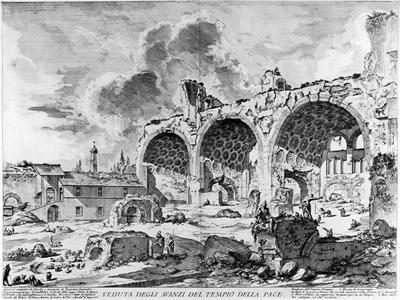

40 Piranesi was able to focus in on his awareness of what was noble and magnificent and gain a sense for the sublime in the architectural tradition of Rome. Moreover, Piranesi’s interest in ruins was genuine antiquarian desire to preserve and record. Nevertheless, these views of Rome firmly established Piranesi’s reputation and gave him the initial financial stability that enabled him to tackle grander themes. These changes could possibly be a response to market demand and what Grand Tourists wanted to see in their vedute, or it could be a personal style change as Piranesi became intrigued by the idea of the sublime.

They also specifically concentrate on a monument, like the “Veduta del Ponte Salario,” or ruin instead of portraying a sweeping view of Roman landscape. His later views featured heavier line, a sublime eye, and more dramatic perspectives. As represented in the “Veduta della Piazza della Rotonda,” Piranesi, clearly contorting perspective, etched an exaggerated and extended view of the Rotonda, unfocused on a specific aspect of the scene. The little figures present at the ground level are the everyday people and visitors in contemporary Rome. In his first views, the monument or subject was drawn from a distance so that it was clearly set in its context. The first thirty-four views were published in a single volume and entitled Le Magnificenze di Roma. His early sites include obvious popular sights, such as Piazza della Rotonda and the Sepolcro di Cecilia Metella. 39 The views were intended as tourist souvenirs and, from their instant popularity, Piranesi had obviously judged the market well. This influenced European thought to such an extent that Grand Tourists, who had come to know Rome through Piranesi’s prints, were recorded as being disappointed on their first encounter with the real thing. Piranesi’s Vedute, which overshadowed competitor’s views of Roman landmarks through compelling compositions, strong lighting contrasts, and dramatic presentation, shaped European conceptions of present day Rome.
Piranesi roman series#
The range of his artistic productions-from objective architectural plans to elaborate architectural fantasies, from urban scenes of eighteenth-century Rome to imaginary scenes of subterranean torture-demonstrate visually many of the thematic tensions that animate literary works of the following decades.Giovanni Battista Piranesi, Veduta del Ponte Salario (View of the Ponte Salario), plate 55 from the series "Vedute di Roma" (Views of Rome), 1754, etching (Davis Museum)īy 1747, Piranesi had begun work on the Vedute di Roma, and he continued to create plates for this series until he died in 1778. Piranesi’s works straddle the boundary between neoclassicism’s emphasis on order and the classical ideal and Romanticism’s emphasis on the imagination and the individual. In this seminar, Piranesi’s visual meditations on the lost glories, shadowy corners, and persistent beauty of ancient Roman architecture served to introduce students to the literary and cultural period of Romanticism.
Piranesi roman professional#
In Spring 2017 I taught an honors college seminar that met in Rare Books and Special Collections called “Piranesi and Romanticism: Architecture and the Literary Imagination.”īorn in Venice, Piranesi made his professional and cultural home in Rome, where his works were sold individually and bound in publications including Antichità romane (1756), Vedute di Roma (1748), and Carceri d’invenzione (1750). Piranesi’s works reveal significant transitions in archaeology, aesthetics, architecture, engraving, and print, and they inspired many of the great names of nineteenth-century literature. He is known for his meticulous and fanciful engravings of Roman architecture, ancient and modern, as well as his “imaginary prisons.” In his engravings, lush vines hang over classical ruins, eighteenth-century scholars cast light in the shadows of long-hidden family crypts, and faceless prisoners climb endless staircases past skulls and bones. The University of South Carolina is one of six institutions worldwide to own a complete twenty-nine volume set of the works of the eighteenth-century architectural illustrator Giovanni Battista Piranesi (1720-1778).


 0 kommentar(er)
0 kommentar(er)
